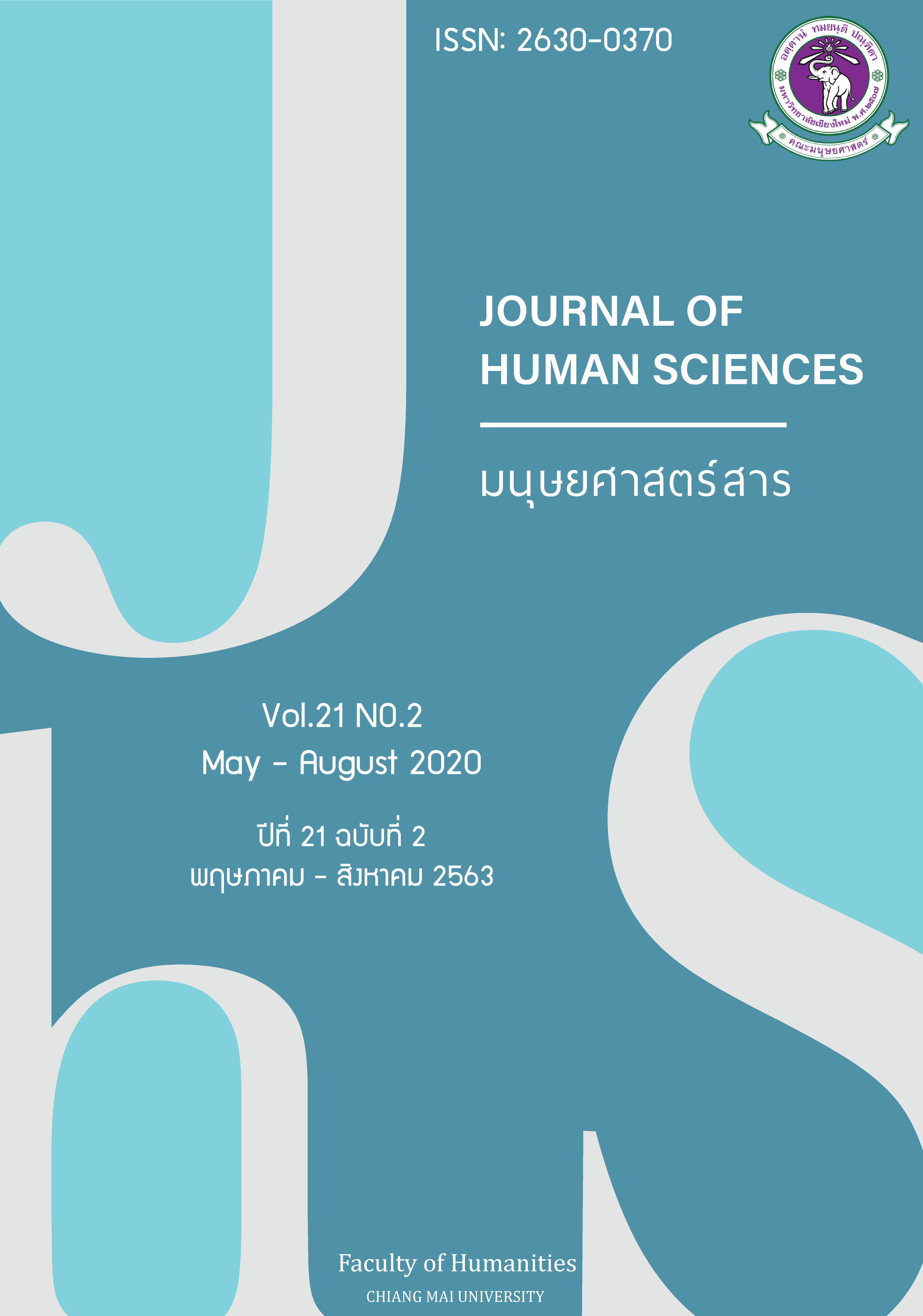การออกแบบสภาพแวดล้อมที่ช่วยฟื้นฟูจิตใจจากความเหนื่อยล้าและพัฒนาการเรียนรู้ ของเด็กออทิสติก คลินิกจิตเวชเด็ก โรงพยาบาลมหาราชนครเชียงใหม่
Main Article Content
บทคัดย่อ
สาเหตุหนึ่งที่ทำให้เด็กออทิสติกมีพฤติกรรมเชิงลบ เช่น หงุดหงิดง่าย คือความเหนื่อยล้าจากการเรียน หรือจากการบำบัดรักษาอย่างต่อเนื่อง ซึ่งทำให้เด็กขาดความสนใจต่อครูผู้สอน จากทฤษฎีฟื้นฟูความสนใจ แสดงให้เห็นว่าสภาพแวดล้อมธรรมชาติช่วยฟื้นฟูจิตใจจากความเหนื่อยล้าได้ งานวิจัยนี้จึงศึกษาการปรับเปลี่ยนสภาพแวดล้อม โดยใช้องค์ประกอบตามทฤษฎีฟื้นฟูความสนใจ ในการออกแบบสภาพแวดล้อม 3 ระดับ คือ 1) สภาพแวดล้อมเดิม 2) สภาพแวดล้อมจำลองธรรมชาติ 2 มิติ และ 3) สภาพแวดล้อมจำลองธรรมชาติ 3 มิติ และทำการศึกษากับกลุ่มตัวอย่างเป็นเด็กออทิสติกที่เข้ารับการบำบัดรักษาที่คลินิกจิตเวชเด็ก รพ.มหาราชนครเชียงใหม่ ทั้งหมด 12 คน โดยใช้แบบประเมิน 3 ชุด ได้แก่ 1) ความสัมพันธ์ของเด็กกับธรรมชาติ (CNS-ch), 2) การรับรู้การฟื้นฟูจิตใจจากความเหนื่อยล้าสำหรับเด็ก 2 (PRCS-CII) และ 3) ทักษะการเรียนรู้ในการทำกิจกรรม (ABC) ซึ่งพยาบาลผู้ดูแลจะเป็นผู้ทำแบบประเมินทั้ง 3 ชุด จากการสังเกตพฤติกรรมของเด็ก ในการทำกิจกรรมบำบัดในสภาพแวดล้อมแต่ละระดับ เป็นเวลาระดับละ 3 สัปดาห์ เพื่อศึกษาผลของการปรับเปลี่ยนสภาพแวดล้อม 3 ระดับ และเพื่อเป็นแนวทางในการออกแบบสภาพแวดล้อมที่มีผลต่อการรับรู้การฟื้นฟูจิตใจจากความเหนื่อยล้า และการเรียนรู้ของเด็กออทิสติก จากผลการวิจัยพบว่ากลุ่มตัวอย่างมีค่าเฉลี่ยจากการประเมิน CNS-ch, PRCS-CII และ ABC สูงที่สุดเมื่ออยู่ในสภาพแวดล้อมจำลองธรรมชาติ 3 มิติ รองลงมาคือเมื่ออยู่ในสภาพแวดล้อมจำลองธรรมชาติ 2 มิติ และสภาพแวดล้อมเดิม ตามลำดับ จากผลการวิจัยจึงมีข้อแนะนำว่าสามารถใช้สภาพแวดล้อมจำลองธรรมชาติ 3 มิติ นำมาเป็นแนวทางในการออกแบบห้องเรียนเพื่อช่วยฟื้นฟูจิตใจจากความเหนื่อยล้า และช่วยพัฒนาการเรียนรู้ของเด็กออทิสติกได้
Article Details
เอกสารอ้างอิง
Ahmad, S., Shaaria, M., Hasimb, R., & Kariminiaa, S. (2015). Conducive Attributes of Physical Learning Environment at Preschool Level for Slow Learners. Social and Behavioral Sciences. 201. 110-120.
Aeksupapan, N. 2018. Itthiphon si khong phanang nai hong rian thi mi phon to dek othittik [The Effect of Wall Color on Awake of Thai Autism Children]. (Master of Thesis, Kasetsart University)
Bagot, K. (2004). Perceived Restorative: A Scale for Children. Children, Youth and Environment, 14(1). 107-129.
Bagot, K., Kuo, F., & Allen, F. (2007). Amendments to the Perceived Restorative Components Scale for Children (PRCS-CII). Children, Youth and Environment, 17(4). 124-127.
Berman, M., Joides, J. & Kaplan, S. (2008). The Cognitive Benefits of Interacting with nature. Psychology Science, 19(2). 1207-1212.
Berto, R. (2005). Exposure to restorative environments helps restore attention capacity. Journal of Environmental Psychology, 25(3). 249-259.
Berto, R., Pasini, M., & Barbiero, G. (2012). Biofiliasperimentale. Culture dellaSostenibilità, 10. 161-184.
Berto, R., Pasini, M., & Barbiero, G. (2015). How Dose Psychological Restoration Work in Children? An Exploratory Study. Journal of Child and Adolescent Behavior. 3. 1-9.
Chaichan, S. (1999). kannam sanœ rupbæp kanchai su singphim prako̜p kan rian kanso̜n anamai suan bukkhon tam næo suk banyat hæng chat samrap khru rongrian prathom suksa sangkat samnakngan khana kammakan kan prathom sưksa hæng chat / suttharat chaichan [A proposed printed media utilization model for personal hygiene instruction according to the national health recommendations for elementary school teachers under the Jurisdiction of the Office of the National Primary Education Commission]. (Master of Thesis, Chulalongkorn University)
Chang, Y. & Chang, C. (2010). The benefits of outdoor Activities for Children with Autism. Society and Resource Management. Retrieved from https://www.researchgate.net/publication/266369570_The_Benefits_of_Outdoor_Activities_for_Children_with_Autism
De Kort, Y., Meijnders, A. L., Sponselee, A. A. G., & Ljsselsteijn, W. A. (2006). What’s wrong with virtual trees? Restoring Stress in a mediated environment. Journal of Environmental Psychology, 26. 309-320.
Felsten, G. (2009). Where to take a study break on the college campus: An attention restoration theory perspective. Journal of Environmental Psychology, 29(1). 160-167.
Google Collection. (2019). Autumn and Color Nature. Retrieved from www.pxhere.com
Green Nature. (2019). Green Nature. Retrieved from www.pxhere.com
Hartig, T., Evans, G. W., Jamner, L. D., Davis, D. S., & Garling, T. (2003). Tracking restoration in natural and urban field settings. Journal of Environmental Psychology, 23. 109-123.
Hartig, T., Kaiser, F., & Bowler, P. (1997). Further Development of a Measure of Perceived Environmental Restorativeness. Gavle, Sweden: Uppsala University, Institute for Housing Research.
Herzog, W., Zeng, X., Lele, Z., Sonntag, C., Ting, J., Chang, C., & Hammerschmidt, M. (2003). Adenohypophysis formation in the zebrafish and its dependence on sonic hedgehog. Developmental Biology, 254(1). 36-49.
Ivarsson, C. & Hagerhall, C. (2008). The Perceived Restorativeness of Gardens – Assessing the Restorativeness of A Mixed Built and Natural Scene Type. Urban Forestry & Urban Greening, 7(2).
Jongjrit, M. (2013). Su watsadu sam miti [3D Materials]. Retrieved From http://metinee53040916.blogspot.com/2013/
Kanakri, S., Shepley, M., Varni, J., & Tassinary, L. (2017). Noise and Autism Spectrum Disorder in Children: An Exploratory Survey. Research in Developmental Disabilities, 63. 85-94.
Kaplan, R., & Kaplan, S. (1989). The Experience of Nature – A Psychology Perspective. Cambridge, NY: Cambridge University Press.
Kaplan, S. (1992). The Restorative Environment: Nature and Human Experience. In D. Relf, (Eds.), The Role of HorticJnue in Human Well-Being and Social Development (p.134-142). Portland, OR: Timber Press.
Kaplan, S. (1995). The Restorative Benefits of Nature: Toward an integrative Framework. .Journal of Environmental Psychology, 5(1). 169-182.
Kjellgren, A., & Buhrkall, H. (2010). A comparison of the Restorative Effect of a Natural Environment with that of Simulated Natural environment. Journal of Environmental Psychology, 30(4). 464-472.
Korpela, K., Bloom, J., & Kinnunen, U. (2014). From Restorative Environments to Restoration in Work. Intelligent Buildings International, 7(4). 215-223.
Kraiphiphule, P. (2015). kham nænam kon wai rian samrap phupokkhrong [Preschool guide for parents]. Retrieved From http://www.pluakdaeng.go.th/attachments/article/4178/คู่มือก่อนวัยเรียน-2561-ศพด...pdf.
Limsila, P. (1993). sathit kaset . . . rongrian hæng ræk samrap dek o̜thittik nai Echia [Sathit kaset...The First School for Autism Children in Asia]. Manager Newspaper.
MacAulay, D. (2006). Classroom Environment: A literature review. Education Psychology, 10(3). 239-253.
Mostafa, M. (2008). An Architecture For Autism: Concepts of Design Intervention for the autistic user. Journal of Architectural Research, 2(1). 189-211.
Noiprawat, N., & Sahachaisaeree, N. (2012). Interior Environment Enhancing Physical Treatment: A case of child Autistic Medical Development. Social and Behavioral Sciences, 38. 108-113.
Noomkalaya, P. (2008). Chittawitthaya kanrapru kan rianru læ chittawitthaya kanphatthana kan [Cognitive psychology Learning and developmental psychology]. Retrieved From http://piyakun-je.blogspot.com/2008/
Rajanukun Institute. (2014). Khumu dek othittik samrap phomae / phupokkhrong [Autism Children Guide for Parents/Guardians]. Bangkok: Printing house.
Samuel, V.C. (1970). Proceedings of the council of Chalcedon and its historical problems. The Ecumenical Review, 22(4). 301-446.
Stephan, M., & McPherson, F. (2004). The connectedness to nature scale: A measure of individuals feeling in community with nature. Journal of Environmental Psychology. 24(4). 503-515.
Taylor, A. F.m, & Kuo, F. E. (2009). Children with attention deficits concentrate better after walk in the park. Journal of Attention Disorders, 12(5). 402-409.
Tennessen, C. & Cimprich, B. (1995). Views to nature: Effects on attention. Journal of Environmental Psychology, 15(1) 77-85.
Wells, N. (2000). At Home with Nature: Effects of “Greenness” on Children’s Cognitive functioning. Environment and Behavior, 36(2). 775-795.


